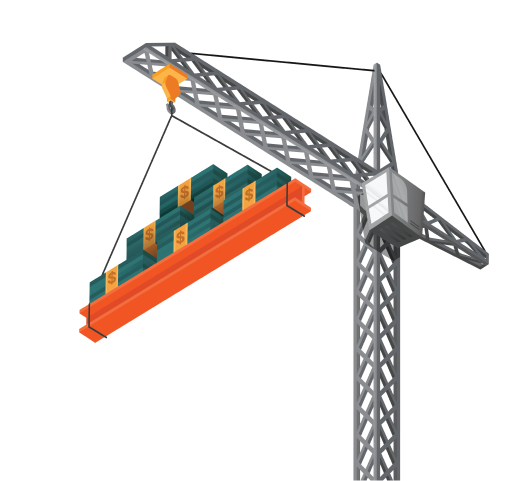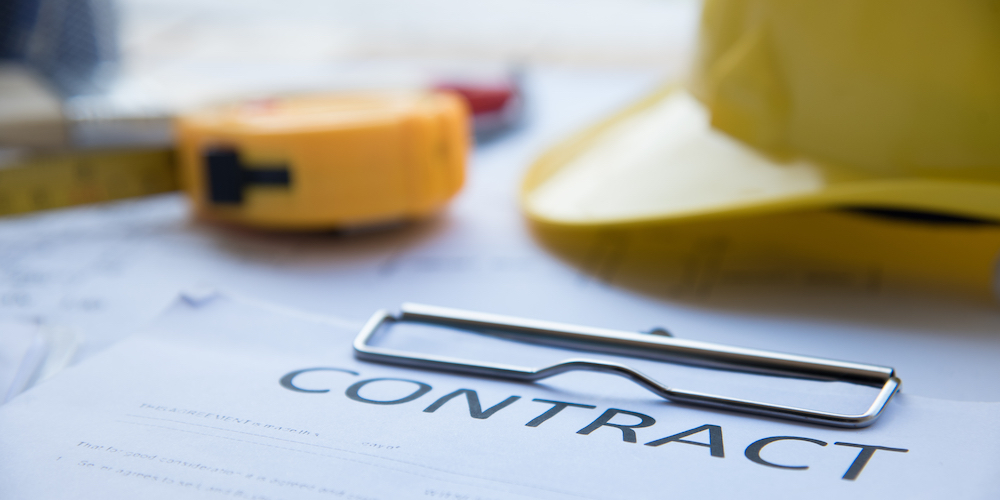— 14 min read
Guide to Guaranteed Maximum Price (GMP) Contracts in Construction
Last Updated Dec 18, 2023

A guaranteed maximum price (GMP) contract sets a maximum price for a construction project, beyond which the contractor absorbs additional costs. Sometimes called a construction manager at risk contract, this type of construction agreement minimizes financial risk for the owner because it sets a project cost limit. GMP contracts are often used on larger, more complex projects in which the owner would benefit from contractor input early on in the process.
We’ll take a deeper dive into how GMP contracts work, GMP contract examples, and the pros and cons of GMP contracts.
Table of contents
How GMP contracts work
A GMP contract is a contractual agreement between a contractor and project owner that sets a maximum cost for the construction work of a project. In other words, the contractor commits to completing the project without billing for more than the maximum price laid out in the contract. The contractor is responsible for any costs that exceed the agreed-upon GMP, which would shrink their profitability on a project.
It's important for projects using GMP contracts to have a well-defined set of scope of work, including drawings and specifications as well as site-specific information. Without a detailed and thorough scope of work, contractors could incur unexpected costs and reduce their project profitability.
What’s covered in a GMP contract?
| Item | Description |
| Project costs | Direct costs associated with the construction project, including labor, materials, equipment, subcontractor profit, and expenses. |
| General conditions | Costs associated with the construction project that cannot be directly attributed to labor, materials, or equipment. |
| Contractor markup | Often charged as a percentage of the total project cost that accounts for the general contractor’s profit and overhead. |
| Contingency | Often a percentage of the GMP that provides the contractor with a financial buffer to account for unforeseen and unknown conditions. |
| Allowances | An amount set aside for known unknowns related to materials, labor, and other project costs. For example, bathroom tile isn’t specified in the construction set so the contract adds in an allowance that provides a unit cost to account for that line item. |
GMP contracts are commonly established between a project owner and a general contractor — a relationship known as the prime contract. However, these types of agreements are also utilized by subcontractors and contractors, especially on projects that demand a specialized level of expertise in a particular trade.
To determine the maximum price for the project, general contractors will do the following:
- Create an initial cost estimate for the entire project
- Reach out to preferred specialty contractors to bid out specific portions of the work
- Determine costs for any work that the GC will self-perform on the project, which may vary according to the general contractor’s specialty
- Make adjustments for general conditions, contingency, allowances, overhead, and profit
- Submit GMP to the owner and begin negotiations
GMP contracts are often harder to negotiate than cost-plus or time and materials contracts because the contractor assumes more financial risk. A GMP agreement is often utilized on larger and more complex projects using project delivery methods like design-build (DB) and construction-manager-at-risk (CMAR).
Learn more: 5 Main Types of Construction Contracts
In design-build projects, the Guaranteed Maximum Price for the project may shift as the design changes with contractor input. Before construction begins, a final GMP is determined and listed in the construction contract.
A GMP contract is an example of an open book contract in which all of the contractor’s costs are transparent to the client. This includes costs for labor, materials, equipment, and other direct costs, as well as indirect costs like markup for overhead and profit. This type of contract promotes the transparency needed for project owners to reimburse costs and know that contractors are not running up the cost to hit the maximum price.
Because GMP agreements and open book contracts require a high degree of trust, they are most frequently used between owners and contractors that already have an established relationship, good communication, and a history of long-term cooperation.
If the project runs over budget, the contractor is responsible for covering the additional costs. However, if the overage is due to the project owner's requested changes to scope, design development outside the scope of work, or unforeseen site conditions, the owner will typically be responsible for paying the additional costs.
The contract outlines the specific procedures and provisions for dealing with cost overruns and scope changes, including under what circumstances these become the contractor's liability or the owner's obligations. Also known as change orders, these amendments to the original contract are binding and outline modifications to the project scope.

Negotiated clauses in a GMP contract
The simplest type of GMP simply sets a fixed maximum price for the contract, above which the contractor absorbs all additional costs. However, there are a variety of modifications that contractors and owners can add. Here are several common types of GMP contracts:
- Shared savings: This type of contract allows for any savings to be shared between the client and the contractor according to a pre-agreed percentage. This can create an incentive for the contractor to find cost savings during the project and for the owner to lean on the GC’s expertise and approach to the project.
- Contingency: In this arrangement, a contingency amount is included in the GMP to cover unexpected costs. If the contingency is not used, it can be returned to the client, or it can be shared between the client and the contractor.
- Escalation clause: This type of contract accounts for potential increases in materials or labor costs during the life of the project. It allows the GMP to be adjusted based on certain defined conditions, such as changes in market conditions.
- Allowances: This type of contract sets a GMP but includes specific allowances for certain items that may have uncertain costs or materials that have not yet been specified or selected at the beginning of the project. If these allowances are not fully used, the remaining funds may be returned to the client or shared.
Importantly, contracts rarely fit into simple categories. Project owners often use tailor-made GMP contracts that are developed for specific projects, but they will nonetheless frequently contain clauses like those listed above to create incentives and modifications for contractors.
Stay Ahead & Leave Risk Behind
Manage, baseline, and improve your quality and safety program from your desktop and mobile devices.

Advantages of GMP contracts
GMP contracts provide benefits for both project owners and contractors.
| For Owners | For Contractors |
| Budget certainty The contractor is responsible for managing the project within the agreed-upon budget (or guaranteed maximum price), minimizing cost overruns. | Greater control The contractor is responsible for managing the costs and schedule of the project, which gives them greater control over the entire process. |
| Quality control The contractor is responsible for ensuring that the project meets the owner's requirements and specifications. | May include incentives Some GMP contracts include performance incentives to encourage lower costs such as split sharing, which splits the project savings between the contractor and owner. |
| Reduced risk A GMP contract shifts risks associated with cost overruns and project delays to the contractor, providing greater protection against unexpected costs or delays. | Potentially higher fee Due to the contractor’s inherent risk with a GMP, they can often charge a higher fee, which the GC can safeguard with greater control over the project and costs. |
| Increased transparencyOpenbook accounting throughout the entire process enables owners to track the true costs as the project unfolds. | Minimize unexpected outcomes Because the GC is involved earlier in the project, they have greater influence over the design and approach, enabling them to develop a realistic GMP. |
| Higher-quality end product GMP is a collaborative process between the owner, architect, and contractor. This creates a more holistic approach to decision-making and often delivers a higher-quality project. | Opportunity to foster trust The transparency and strong relationship needed to successfully execute a GMP contract can enable contractors to establish trust that paves the way for potential future partnerships. |
In general, project owners who are more concerned about ensuring project cost certainty without compromising quality benefit from using GMP contracts.
For general contractors, GMP contracts provide a strong potential for profitability if the GC accurately develops the budget and effectively manages the project.
Overall, GMP contracts balance the cost reimbursement characteristics of a cost-plus contract with the cost predictability of a lump sum contract.
Disadvantages of GMP contracts
Although a GMP contract offers advantages, there are also some drawbacks for the involved parties, which can be reduced by formulating a well-structured contract, establishing a good relationship, and conducting comprehensive preconstruction efforts.
| For Owners | For Contractors |
| Unforeseen and unknown conditions With a GMP agreement, unforeseen or unknown conditions are often the financial responsibility of the owner. | Requires detailed, careful review of specifications Not all costs are considered the owner’s responsibility, so contractors must review the contract carefully to ensure profitability. |
| Requires a trusted partner Without a trusted partner, owners may worry that the GC is inflating costs or trying to cut corners to increase their profit, resulting in lower-quality work. | Requires meticulous cost tracking The GC must provide detailed documentation of costs throughout the project and to receive compensation. This administrative work requires significant time and effort. |
| Potential for disputes Disputes may occur over what costs fall under the GMP, particularly for unforeseen or unknown items, as the owner bears ultimate responsibility for the project cost. | Change orders disputes Because the contractor should have accounted for all costs in the GMP, change orders are often disputed. |
A comprehensive and thorough GMP contract can prevent these downfalls by including detailed project requirements and specifications, precise cost estimates, and a meticulous understanding of potential risks and mitigation strategies.
Trust that creates a foundation for collaboration is key in a GMP contract. In an established long-term relationship between owner and contractor, both parties are incentivized to come together to formulate solutions that benefit all as well as the final work product.
GMP contract template
The A102, a sample GMP contract published by the American Institute of Architects (AIA), is commonly utilized by many owners and contractors as a foundation for their GMP construction agreement.
This template outlines the essential components of a GMP contract, such as reimbursable costs and the contractor's fee. It also includes standard sections covering payments, insurance and bond requirements, dispute resolution, contract termination, and more. Although templates are helpful starting points for creating a GMP contract, they usually require customization to match the specific requirements of a project or the priorities of a firm.
Example of a GMP contract
Let’s examine how a GMP contract works in the case of a hypothetical construction project.
A commercial real estate company approaches Gray Construction, a general contractor they’ve previously worked with, to help transform an existing warehouse space into a mixed-use building. Due to the complexity of the project, the owner decides to use a GMP contract with a design-build delivery method to help bring the contractor on earlier in the process. The trust these two businesses have already established makes a GMP contract arrangement less risky for both parties.
The contractor works closely with the architect to advise on the cost of different design options, materials, labor availability, and scheduling during design development. Throughout the development of the project, the general contractor will coordinate with specialty contractors to determine the pricing for various building components. This immediate pricing feedback enables an iterative design approach that leads to a more cost-effective project. The aim for the contractors and designers during this phase is to produce a set of construction drawings that are realistic within a set budget.
Gray Construction then provides a GMP proposal to the owner. In addition to the detailed breakdown of all costs, including overhead and profit, the proposal includes any allowances or contingencies for unforeseen circumstances as well as terms and general conditions, such as how to resolve any disputes that arise. The project owner reviews the GMP proposal and negotiates with Gray Construction to ensure that they are receiving a fair and reasonable price.
The two parties reach an agreement and both sign the GMP contract. Gray Construction is responsible for ensuring that the project is completed within the guaranteed maximum price, and any cost overruns are their responsibility. However, in this instance, both parties negotiated that if the project is completed under budget, the savings are shared between the project owner and the contractor. This incentivizes the contractor to find ways to reduce the cost of the project without sacrificing quality, potentially increasing profitability for both parties.
Throughout the project, Gray Construction provides regular updates on the project's progress and any changes that may impact the cost. If there are any changes or unforeseen circumstances that will affect the project's cost, the contractor must reconcile these differences in alignment with the language of the agreement. As long as both the general contractor and the owner agree on the change, the contract is amended and construction continues. Occasionally, two parties may need to use the dispute resolution process spelled out in the contract, which often involves binding arbitration.
During the demolition phase, Gray Construction discovers that the building's structure is unsound and it requires a structural upgrade, which was not accounted for in the scope of work. As per the GMP agreement, this unforeseen condition is not the contractor's responsibility. However, since both parties were aware that adaptive reuse projects involve significant renovation work and carry unknown risks, substantial contingencies were set aside. Gray Construction informs the owner of the situation, and the owner agrees to utilize some of their contingency funds to cover the cost of the structural upgrade, ensuring that the project can proceed without any additional expenses.
As they complete their portion of the work, each subcontractor submits a pay application to Gray Construction, who then reviews and approves it. Usually on a monthly basis, Gray Construction includes the subcontractor's invoice amount in the next application for payment to the owner. Once the owner approves the application for payment, the general contractor releases payment to the subcontractor.
Upon contract completion, Gray Construction provides the owner with as-built drawings, warranties, and operation and maintenance manuals. The owner conducts a final inspection and approves payment to Gray Construction to cover their costs and fees. Gray Construction addresses any final items in the punch list and pays any retainage to its specialty contractor partners.
Gray Construction discovers that the project was completed $300,000 below the GMP budget. As per the split-savings clause specified in the GMP contract, they will receive 30% of the savings, and the remaining 70% will be returned to the owner, leading to increased profitability for both parties.
By using a GMP agreement, Gray Construction provided the owner with a guaranteed maximum price for their work, resulting in greater cost certainty and peace of mind. The collaborative relationship between the owner and Gray Construction delivered a high-quality construction project under budget, allowing both parties to maximize their profitability.
Mitigating risk on GMP contracts
During GMP contract formation, owners and contractors can use a variety of strategies to reduce their risk on a project. The profitability of projects is set up during the contract formation phase.
To prevent future misunderstandings or disagreements, both parties should thoroughly review and analyze all documents that contribute to the scope of work. By identifying potential issues and assessing their likelihood and potential impact, both parties can develop strategies to address these concerns in the contract.
Both parties should carefully review and negotiate contract terms to ensure that they are fair, reasonable, and clearly delineated. The contract should also establish a well-defined change order process that outlines how changes to the project will be handled, including cost and schedule impacts. Lastly, entering into GMP contracts that are based on the foundation of established relationships creates an environment where all parties approach the project collaboratively with the goal being to deliver the highest quality work.
A clearly defined GMP contract can deliver profitability for both the general contractor and owner, even for complex projects or those with unknown conditions.
Categories:
Tags:
Written by
Taylor Riso
37 articles
Taylor Riso is a marketing professional with more than 10 years of experience in the construction industry. Skilled in content development and marketing strategies, she leverages her diverse experience to help professionals in the built environment. She currently resides in Portland, Oregon.
View profileD. Jesse Mase
D. Jesse Mase has a wealth of experience spanning architecture, construction, and real estate investment. His passion for the built environment led him to self-employment as a design builder, and later, managing large-scale commercial construction projects at Trehel Corporation. Currently, Jesse leverages his industry insights in his role as Principal Strategic Product Consultant at Procore, streamlining processes and solutions for construction project owners.
View profileReviewed by
Jeffrey Brooks
Jeffrey Brooks is a Solutions Engineer at Procore, where he helps general contractors evaluate Procore from a technical perspective. Prior to joining Procore, Jeffrey was a project manager for a large commercial general contractor in Denver, where he managed in excess of $375M for construction projects between 2014 and 2022.
Griffin Marquardt
Griffin Marquardt is a strategic product consultant with 25 years of experience in the building industry. His past experience includes space planning, on-site field supervision, construction management, general contracting, and architecture design.
Win More Work
Get discovered for relevant work on the Procore Construction Network.

Explore more helpful resources

Contract Precedence: A Clause to Clear Construction Confusion
Construction contracts are usually lengthy and complicated, composed of a wide range of documents In a perfect world, the contract provides the clarity and direction all stakeholders need to move...

Construction Contract Administration: Roles & Responsibilities
Construction contracts, especially for large projects, can be extremely detailed with many key documents often compiling thousands of pages. Because of this, larger firms have a dedicated role to keep...

Construction Contract Documents: 9 Key Components
Every construction project — whether a small-scale residential renovation or an extensive municipal development — requires a contract. Construction contracts are multifaceted, often comprising numerous documents that cumulatively define the...

Job Order Contracting (JOC) Explained
Contracts for commercial construction projects usually cover a complete scope of work, but large institutions often have ongoing needs for smaller projects. This is where job order contracting (JOC) comes...
